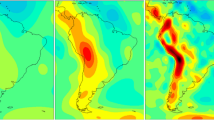Abstract
The correlation between frequency variations in the Earth’s rotation and geomagnetic jerks is analyzed on the interval from 1900 to 2008. It is found that jerks precede changes in the rate of the Earth’s rotation frequency in the interval of periods ranging from 5 to 8 years. A mechanism of jerks generation is suggested in which the jerks are considered as the result of the excitation of magnetorotational instability in the Earth’s core with the subsequent generation of torsional oscillations causing a change in the Earth’s rotation frequency.
Similar content being viewed by others
References
Abarca del Rio, R., Gambis, D., and Salstein, D.A., Interannual signals in length of day and atmospheric angular momentum, Ann. Geophys., 2000, vol. 18, pp. 347–364.
Alexandrescu, M., Gibert, D., Hulot, G., and Le Mouel, J.L., Worldwide wavelet analysis of geomagnetic jerks, J. Geophys. Res., 1996, vol. 101, pp. 21975–21994.
Bellanger, E., Gibert, D., and LeMouel, J.-L., A geomagnetic triggering of Chandler wobble phase jumps?, Geophys. Rev. Lett., 2002, vol. 29, no. 7, pp. 28–1 to 28-4.
Bloxham, J., Zatman, S., and Dumberry, M., The origin of geomagnetic jerks, Nature, 2002, vol. 420, pp. 65–68.
Braginskii, S.I., Magnetohydrodynamical torsional oscillations in the Earth’s core and variations in the length of the day, Geomagn. Aeron., 1970, vol. 10, no. 1, pp. 3–19.
Chuliatt, A. and Maus, S., Geomagnetic secular acceleration, jerks, and a localized standing wave at the core surface from 2000 to 2010, J. Geophys. Res., 2014, vol. 119, pp. 1531–1543.
Excess of the duration of the day to 86400s and angular velocity of the Earth’s rotation since 1623. http://hpiers. obspm.fr/eop-pc/earthor/ut1lod/lod-1623.html. Accessed August 31, 2015.
Gillet, N., Jault, D., Canet, E., and Fournier, A., Fast torsional waves and strong magnetic field within the Earth’s core, Nature, 2010, vol. 465, pp. 74–77.
Golovkov, V.P., Geomagnetic field acceleration, Geophys. Astrophys. Fluid Dyn., 1991, vol. 60, nos. 1-4, p. 392.
Holme, R. and de Viron, O., Geomagnetic jerks and a highresolution length-of-day profile for core studies, Geophys. J. Int., 2005, vol. 160, no. 2, pp. 435–439.
Jackson, A., Time-dependency of tangentially geostrophic core surface motions, Phys. Earth Planet. Inter., 1997, vol. 103, pp. 293–311.
Jault, D., Gire, C., and Le Moule, J.L., Westward drift, core motions and exchanges of angular momentum between core and mantle, Nature, 1988, vol. 333, pp. 353–356.
Mandea, M., Holme, R., Pais, A., Pinheiro, K., Jackson, A., and Verbanac, G., Geomagnetic jerks: rapid core field variations and core dynamics, Space Sci. Rev., 2010, vol. 155, no. 1, pp. 147–175.
Pais, M.A. and Jault, D., Quasi-geostrophic flows responsible for the secular variation of the Earth’s magnetic field, Geophys. J. Int., 2008, vol. 173, pp. 422–443.
Shalimov, S.L., On the minimal instability time of hydromagnetic flows in the Earth’s core, Izv., Phys. Solid Earth, 2013, vol. 49, no. 5, pp. 743–745.
Shalimov, S.L., Magnetorotational instability in the Earth’s core, Izv., Phys. Solid Earth, 2014, vol. 50, no. 4, pp. 463–466.
Velikhov, E.P., The stability of the flow of perfectly conductive fluid between the rotating cylinders in the magnetic field, Zh. Eksp. Teor. Fiz., 1959, vol. 36, no. 5, p. 1398.
Author information
Authors and Affiliations
Corresponding author
Additional information
Original Russian Text © S.L. Shalimov, E.V. Ol’shanskaya, 2016, published in Fizika Zemli, 2016, No. 6, pp. 149–153.
Rights and permissions
About this article
Cite this article
Shalimov, S.L., Ol’shanskaya, E.V. On the frequency variations in the Earth’s rotation caused by unstable flows in the liquid core. Izv., Phys. Solid Earth 52, 923–927 (2016). https://doi.org/10.1134/S1069351316060100
Received:
Published:
Issue Date:
DOI: https://doi.org/10.1134/S1069351316060100




